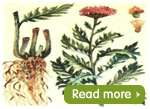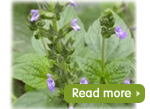OUR TECHNOLOGY
 Synergistic gardening is a system of organic gardening, developed by Emilia Hazelip, and based on the work of Masanobu Fukuoka. The approach is a type of permaculture. After establishing the garden, there is no further digging, ploughing or tilling, and no use of external inputs such as manures and other fertilizers, or pesticides. Soil health is maintained by the selection of plants, mulching, and recycling of plant residues.
Synergistic gardening is a system of organic gardening, developed by Emilia Hazelip, and based on the work of Masanobu Fukuoka. The approach is a type of permaculture. After establishing the garden, there is no further digging, ploughing or tilling, and no use of external inputs such as manures and other fertilizers, or pesticides. Soil health is maintained by the selection of plants, mulching, and recycling of plant residues.
OUR PLANTS


1. Maral Root (Leuzea carthamoides) - Outside Russia, maral root is found only in Mongolia. It grows in sufficiently moistened alpine-meadow, podsolized soils; it is abundantly represented in such habitats as tall-grass subalpine meadows, while in the mountain forest areas it is found in forest meadows and open fir-pine forests. Rarely, maral root is found in alpine meadows. For the first time, in the scientific literature the plant was mentioned in a paper of G.N. Potanin, Russian explorer of Siberia and ethnographer. Maral root is a good nectariferous plant: bees gather nectar and pollen from its flowers. Read more about Maral root

2. Golden Root (Rhiodola rosea) - (Golden Root, Roseroot, Aaron's Rod) is a plant in the Crassulaceae family that grows in cold regions of the world. These include much of the Arctic, the mountains of Central Asia, the Rocky Mountains, and mountainous parts of Europe, such as the Alps, Pyrenees, Carpathian Mountains, Scandinavia, Iceland, Great Britain and Ireland. The perennial plant grows in areas up to 2280 meters elevation. Several shoots grow from the same thick root. Shoots reaches 5 to 35 cm in height. Rhodiola rosea is dioecious – having separate female and male plants.
Rhodiola rosea may be effective for improving mood and alleviating depression. Read more about Golden root

3. Five Flavor Berry (Schisandra chinensis) - Its berries are used in traditional Chinese medicine, where it is considered one of the 50 fundamental herbs. They are most often used in dried form, and boiled to make a tea. Medicinally it is used as a tonic and restorative adaptogen with notable clinically documented liver protecting effects. The primary hepatoprotective (liver protecting) and immuno-modulating constituents are the lignans schizandrin, deoxyschizandrin, gomisins, and pregomisin, which are found in the seeds of the fruit. It should not be used by pregnant women. Read more about Five Flavor Berry

4. Burdock Himalayan/Kushta (Saussurea costus) - It is one of the 50 fundamental herbs used in traditional Chinese medicine, where it has the name. In Ayurveda the name Kushta refers to an ancient Vedic plant god mentioned in the Atharvaveda as a remedy for takman, the archetypal disease of excess or jvara (fever). In ancient India Kushta was considered to be a divine plant derived from heavenly sources, growing high in the Himalayas, considered to be the brother of the divine Soma. In Ayurveda Kushta is a rasayana for Vata, helping to normalize and strengthen digestion, cleanse the body of toxic accumulations, enhance fertility, and reduce pain.Read more about Burdock Himalayan

5. Chia (Columbariae) - Is valuable source of nutrients, protein and oil. When roasted, they have a pleasant, nutlike flavor. The Diegueño took chia seeds on journeys where a few seeds kept in the mouth and periodically chewed, would keep up their strength (Hedges & Beresford 1986). One tablespoon of chia seed is said to be enough to supply a person with 24 hours worth of energy. Chia contain a musilagenous substance and expand considerably into a gelatinous volume when moistened. An aromatic, minty beverage could be made by soaking raw chia seeds in water (Saunders 1923). Read more about Chia

6. Kutki Himalayan (Picrorhiza kurroa) - It is found in Himalayan region (Garwal to Bhutan), Southeast Tibet, North Burma and West China. In Nepal, Kutki is distributed abundantly in Alpine Himalaya between 3500 to 4800m. It is found in rocky places of Himalaya. It prefers to grow generally on the rock's crevices. It mostly grows on sloppy and cliffy mountains.
In Nepal it is also found in the eastern and central regions but abundantly in the northwestern region growing on open, stony and grassy slopes, and on the turf of glacial flats. It has a cooling effect and is used as a cardiotonic, antipyretic, anthelmintic and laxative. Read more about Kutki Himalayan

7. Spikenard Himalayan (Nardostachys jatamansi or Nardostachys grandiflora) - It is found in Himalayan region (Garwal to Bhutan), Southeast Tibet, North Burma and West China. In Nepal, Kutki is distributed abundantly in Alpine Himalaya between 3500 to 4800m. It is found in rocky places of Himalaya. It prefers to grow generally on the rock's crevices. It mostly grows on sloppy and cliffy mountains.
In Nepal it is also found in the eastern and central regions but abundantly in the northwestern region growing on open, stony and grassy slopes, and on the turf of glacial flats. Read more about Spikenard Himalayan


